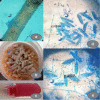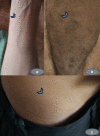Naive tinea corporis et cruris in an Immunocompetent adult caused by a geophile Nannizzia gypsea susceptible to Terbinafine - Rarity in the current scenario of Dermatophytosis in India
- PMID: 32974531
- PMCID: PMC7470300
- DOI: 10.1099/acmi.0.000022
Naive tinea corporis et cruris in an Immunocompetent adult caused by a geophile Nannizzia gypsea susceptible to Terbinafine - Rarity in the current scenario of Dermatophytosis in India
Abstract
Introduction: Dermatophytosis caused by Nannizzia gypsea formerly Microsporum gypse um is rare in occurrence due to its geophilic adaptation and weak pathogenic potential in establishing infection in humans. The taxonomical status of N. gypsea has been controversial over the years and has now reached a concordance among mycologists. Innumerable reports of N. gypsea causing widespread infection in human immunodeficiency virus patients trails them as an important agent of consideration in an immunocompromised host. There have been sporadic reports of N. gypsea causing glabrous skin tinea and onychomycosis in healthy patients and the prevalence reports gravitate around 1-6.5 %. A variety of non-anthropophilic dermatophytes including novel species have now been implicated in causing dermatophytosis reflecting the era of crux changes in the epidemiology.
Case report: We present a case of chronic dermatophytosis in a 22-year-old healthy Indian with a history of contact with a dog and soil and other factors favouring dermatophytosis. Conventional and molecular sequencing established the isolate as N. gypsea. Antifungal susceptibility test revealed a higher MIC of griseofulvin and lower MIC to azoles and terbinafine. The patient had complete clinical resolution following administration of oral terbinafine.
Conclusion: Amidst the hyper-endemic-like scenario of tinea in India, this case report stands as a unique example of a patient infected with N. gypsea showing complete clinical resolution using terbinafine. Studies implicating N. gypsea in an immunocompetent host are rare and there is a need for more studies on geophilic dermatophytes causing tinea in the man for laying down effective preventive measures.
Keywords: CLSI M38A2; ITS sequencing; Nannizzia gypsea; geophile; immunocompetent host; terbinafine; tinea corporis et cruris.
© 2019 The Authors.
Conflict of interest statement
The authors declare that there are no conflicts of interest.
Figures




Similar articles
-
A Case of Tinea faciei Due to Nannizzia gypsea: Inflammatory Eruption on the Medial Angle of the Eyelid.Mycopathologia. 2020 Aug;185(4):699-703. doi: 10.1007/s11046-020-00474-5. Epub 2020 Jul 27. Mycopathologia. 2020. PMID: 32720062
-
Nannizzia species causing dermatophytosis in cats and dogs: First report of Nannizzia incurvata as an etiological agent in Brazil.Med Mycol. 2023 Oct 5;61(10):myad105. doi: 10.1093/mmy/myad105. Med Mycol. 2023. PMID: 37804177
-
Dermatophytosis caused by Nannizzia gypsea: report of 155 cases from Western Mexico.Enferm Infecc Microbiol Clin (Engl Ed). 2025 Apr;43(4):205-209. doi: 10.1016/j.eimce.2024.12.002. Epub 2024 Dec 30. Enferm Infecc Microbiol Clin (Engl Ed). 2025. PMID: 39741026
-
Sertaconazole: a review of its use in the management of superficial mycoses in dermatology and gynaecology.Drugs. 2009;69(3):339-59. doi: 10.2165/00003495-200969030-00009. Drugs. 2009. PMID: 19275277 Review.
-
Terbinafine. An update of its use in superficial mycoses.Drugs. 1999 Jul;58(1):179-202. doi: 10.2165/00003495-199958010-00018. Drugs. 1999. PMID: 10439936 Review.
Cited by
-
Genetic Predisposition and its Heredity in the Context of Increased Prevalence of Dermatophytoses.Mycopathologia. 2021 May;186(2):163-176. doi: 10.1007/s11046-021-00529-1. Epub 2021 Feb 1. Mycopathologia. 2021. PMID: 33523393 Free PMC article. Review.
-
Global Dermatophyte Infections Linked to Human and Animal Health: A Scoping Review.Microorganisms. 2025 Mar 3;13(3):575. doi: 10.3390/microorganisms13030575. Microorganisms. 2025. PMID: 40142467 Free PMC article. Review.
References
-
- Gordon MA, Perrin N. Little GN: differences in pathogencity between M. gypseum and M. fulvum . Sabouraudia. 1967;5:366–370. - PubMed
Publication types
LinkOut - more resources
Full Text Sources
